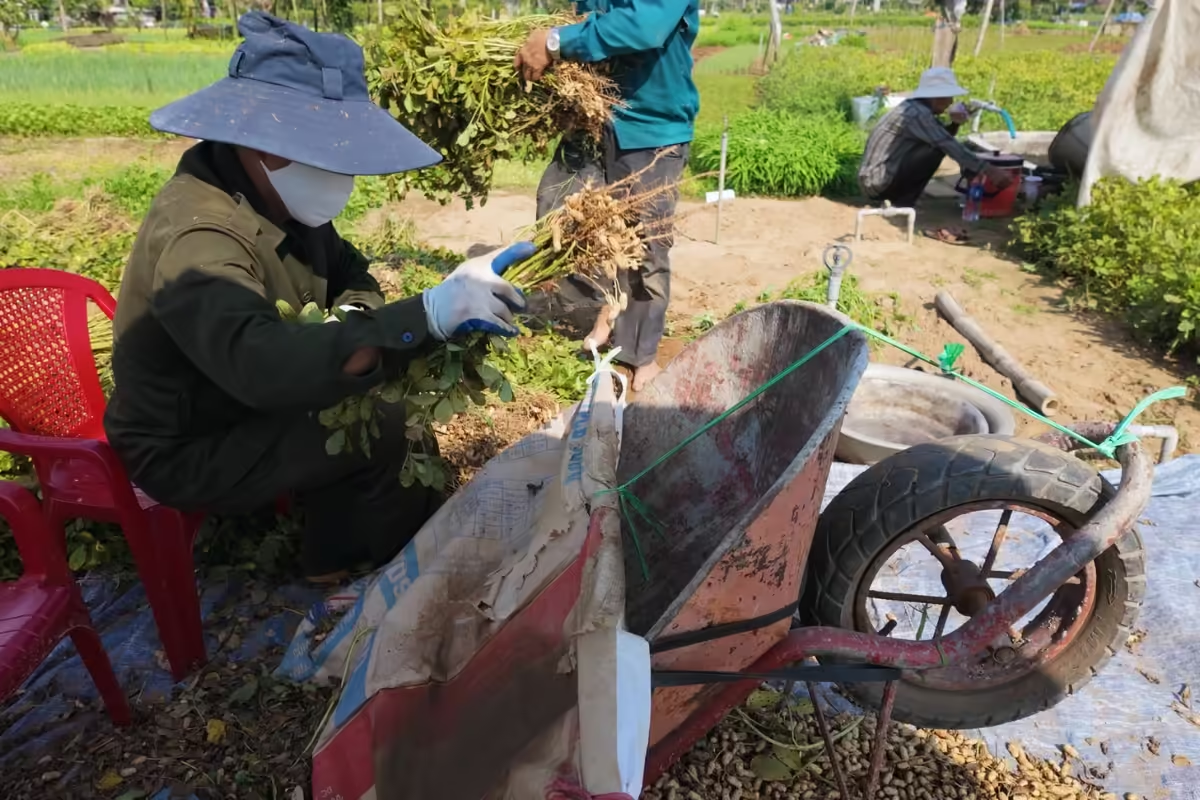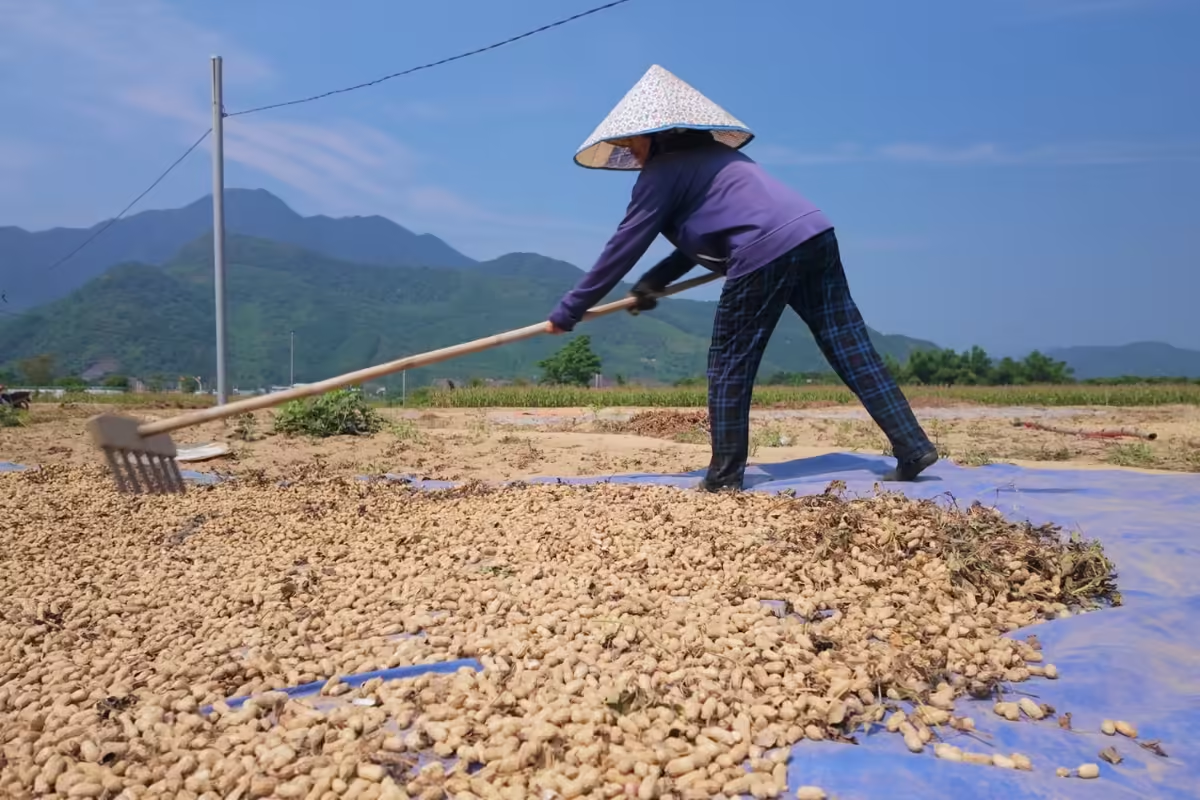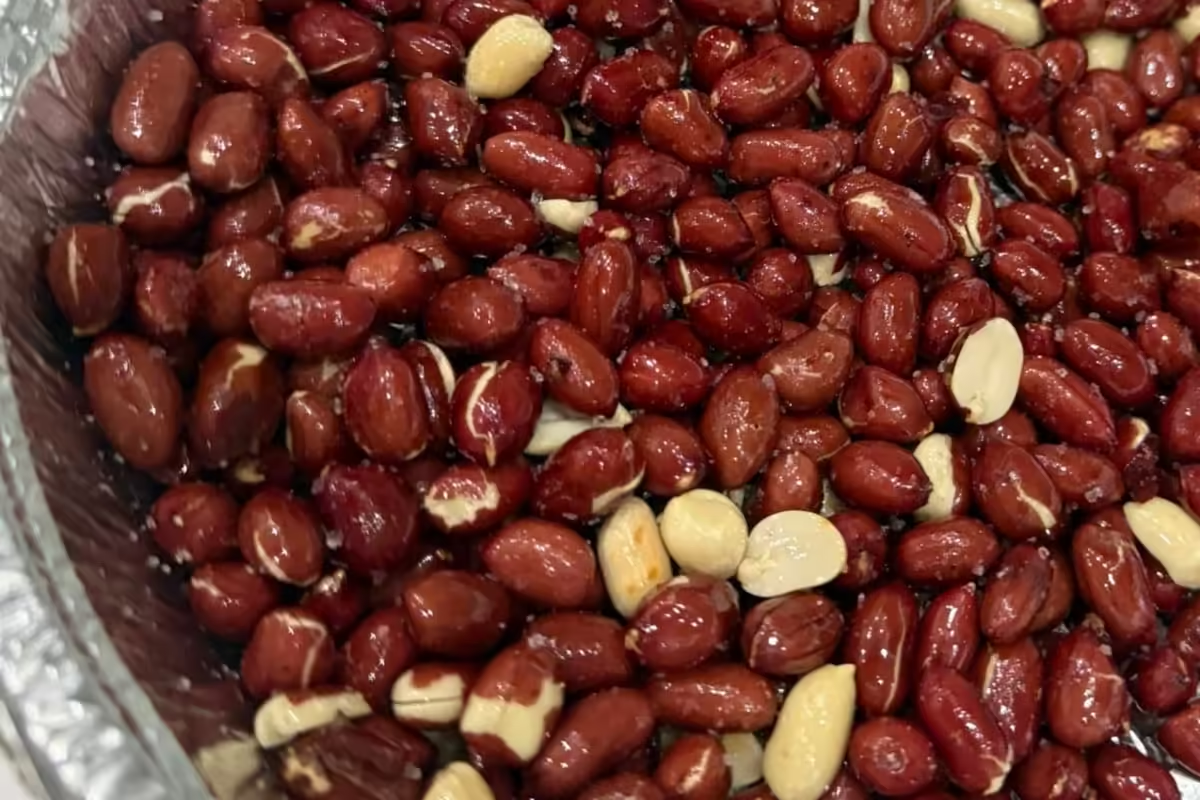Vietnamese peanuts: traditional harvest, health benefits, and culinary uses
In this article, we’ll share some fascinating insights about Vietnamese peanuts — how farmers harvest them by hand, the tasty dishes made from peanuts in Vietnam, and the health benefits they offer. We’ve also included a short video showing the peanut harvest in action — a glimpse into the hard work and tradition behind every peanut.
Watch our short video capturing the real, unfiltered moments of peanut harvesting in Vietnam — filmed on location by our team
Introduction
Harvesting
Drying & shelling
Health benefits
Culinary uses
Where to buy
FAQs
Vietnamese peanuts: A quick introduction

A peanut field in Vietnam during harvest season
Peanuts, known as “lạc” or “đậu phộng” in Vietnamese, thrive in Vietnam’s warm, tropical climate. You’ll find peanut fields scattered across the country, from the northern plains to the southern deltas.
Every year, around April and May, farmers roll up their sleeves and begin the peanut harvest. In the countryside, it’s a familiar and vivid sight — farmers working under the blazing sun, pulling peanut plants from the earth, drying them in the fields, and filling the air with the unmistakable scent of freshly unearthed crops. It’s a hard but deeply rooted tradition that connects generations across Vietnam’s rural landscapes.
How peanuts are harvested in Vietnam

A team of Vietnamese farmers working together to harvest peanuts
Harvesting peanuts in Vietnam is still very much a hands-on, traditional process, especially in the countryside where small family farms are the backbone of agriculture.
When the plants are ready, usually after about four months of growing, farmers head out to the fields with simple tools — or often just their bare hands. They loosen the soil and carefully pull each peanut plant from the ground, revealing clusters of peanuts clinging to the roots.

With bare hands and steady effort, a Vietnamese farmer pulls peanut plants from the soil
After the plants are lifted, farmers get to work separating the peanuts from the roots. It’s a simple method: the men gather bunches of peanut plants in their hands and thwack them against a hard surface, causing the peanuts to shake loose and scatter.
You can hear a steady thud-thud-thud as the work goes on, filling the fields with the sound of harvest. No fancy tools, no complicated machines — just strong hands and a lot of patience. Before long, big piles of freshly picked peanuts start to take shape, ready to be dried under the sun.

Farmers beat peanut plants against hard surfaces to loosen the nuts
Drying and shelling Vietnamese peanuts

Peanuts drying under the scorching sun, as farmers rake them evenly for perfect crispness
After the peanuts are separated from the roots, they’re laid out under the sun to dry — a process that usually takes about 7 to 10 days. Farmers spread the peanuts in thin layers across large tarps, making sure they catch as much sunlight as possible.
During this time, the peanuts slowly lose their moisture until the kernels inside are completely dry. Once they’re ready, farmers crack open the outer shells by hand to reveal the firm, golden peanuts tucked inside. These peanuts are then either used for cooking, from savory dishes to sweet treats, or pressed into oil for use in everyday Vietnamese kitchens.
Nutritional profile and health benefits
1. Nutritional profile
Here’s the nutritional breakdown for a 3.5-ounce (100-gram) serving of raw peanuts, based on data from the USDA:
| Nutrient | Amount |
|---|---|
| Water | 4.82 g |
| Energy | 551–588 kcal |
| Protein | 23.2 g |
| Total Lipid (Fat) | 43.3 g |
| Carbohydrates | 26.5 g |
| Fiber | 8 g |
| Calcium | 49 mg |
| Iron | 1.55 mg |
| Magnesium | 180 mg |
| Phosphorus | 380 mg |
| Potassium | 636 mg |
| Sodium | 1 mg |
| Zinc | 2.78 mg |
| Copper | 0.46 mg |
| Manganese | 1.68 mg |
| Selenium | 17.8 µg |
2. Health benefits of peanuts
Findings from Healthline’s comprehensive review have shown that peanuts offer significant health benefits. Below, we’ve highlighted the main points for you.
 High in healthy fats
High in healthy fats  A great source of plant-based protein, important for muscle growth and repair.
A great source of plant-based protein, important for muscle growth and repair. Packed with vitamins and minerals like magnesium, phosphorus, and potassium.
Packed with vitamins and minerals like magnesium, phosphorus, and potassium. Rich in antioxidants, comparable to the levels found in many fruits.
Rich in antioxidants, comparable to the levels found in many fruits. Can aid in weight management by promoting fullness and reducing overeating.
Can aid in weight management by promoting fullness and reducing overeating. May help protect against heart disease, thanks to their heart-friendly nutrients.
May help protect against heart disease, thanks to their heart-friendly nutrients. It could lower the risk of gallstones, according to some studies.
It could lower the risk of gallstones, according to some studies.How Vietnamese peanuts are used in cooking and snacks
Peanuts complete Mi Quang

A bowl of Mì Quảng topped with roasted peanuts
In Mì Quảng (Quang noodles), a sprinkle of roasted peanuts is a beloved finishing touch. Those golden peanuts do more than add texture — they bring a deep, nutty flavor that ties the whole bowl together. The slight crunch of the peanuts contrasts beautifully with the chewy rice noodles, tender chicken, fresh herbs, and savory broth. Without peanuts, Mì Quảng simply wouldn’t have the same signature character that people across Vietnam love.
Vietnamese peanut snack
In Vietnam, peanuts aren’t just used in cooking — they’re also enjoyed in a variety of everyday snacks. From salted roasted peanuts and crispy peanut brittle to đậu phộng da cá (coated peanuts with a crunchy shell), these simple treats are often found in markets, served with tea, or casually enjoyed at home.
Vietnamese roasted peanuts

Vietnamese roasted peanuts – đậu phộng rang muối – are often prepared by tossing raw peanuts in a bit of oil, then roasting them slowly over low heat. A light sprinkle of salt is added while hot, helping the flavor cling. The result is a rich, toasty snack that’s crunchy and satisfying, commonly enjoyed with tea or beer.
Vietnamese peanut brittle

Another beloved use of peanuts in Vietnam is in kẹo đậu phộng, or Vietnamese peanut brittle. This classic treat is simple yet irresistible — roasted peanuts are coated in caramelized sugar and then pressed into thin, crunchy sheets.
You’ll often find peanut brittle sold in local markets, wrapped in clear plastic bags. Vietnamese peanut brittle has a light, crisp texture that breaks apart easily, releasing the deep, toasty aroma of roasted peanuts with every bite. It’s the perfect balance of sweet and nutty — a simple pleasure that has been enjoyed across generations.
Đậu phộng da cá (crispy-coated peanuts)
Đậu phộng da cá is a crunchy Vietnamese snack made by coating peanuts in a seasoned flour batter and deep-frying them until golden. In English, it’s often referred to as crispy-coated peanuts, and it differs from regular roasted peanuts due to its crispy shell.
Peanut butter
In Vietnam, peanut butter is often eaten with bánh mì because it’s quick, simple, and satisfying. It’s also used to make a dipping sauce for fresh spring rolls filled with pork, shrimp, noodles, and herbs. The sauce blends nutty, savory, and slightly sweet flavors — a perfect match for the freshness of the rolls.
Peanut oil
In Vietnamese kitchens, peanut oil is a common cooking staple, especially in regions where peanuts are grown locally. Known for its light, nutty aroma and high smoke point, peanut oil is ideal for stir-frying, deep-frying, and sautéing.
It enhances the flavor of vegetables, seafood, and meats without overpowering them, making it a favorite in home cooking. Many Vietnamese cooks prefer peanut oil for its ability to bring out the natural richness of ingredients while keeping dishes light and aromatic.
Vietnamese peanuts: Where to buy
If you’re looking to buy Vietnamese peanuts outside of Vietnam, check your local Asian grocery stores or Vietnamese supermarkets. You can also find them online through platforms like Amazon, Weee!, or specialty Asian food retailers.
Common FAQs
Are peanuts native to Vietnam?
Peanuts are not originally native to Vietnam. They are believed to have originated in South America, but were introduced to Vietnam centuries ago and have since become a key part of Vietnamese agriculture and cuisine.
How are peanuts used in Vietnamese cooking?
Peanuts are used in many ways — as toppings for dishes like Mì Quảng, in sauces for spring rolls, as roasted snacks, in peanut brittle (kẹo đậu phộng), in crispy coated peanuts known as đậu phộng da cá, or made into peanut butter that’s sometimes spread on bánh mì.
Can I buy Vietnamese peanuts online?
Absolutely. You can find them on websites like Weee!, Amazon, or other specialty Asian grocery platforms. Look for roasted or raw Vietnamese-grown peanuts for the most authentic flavor.
What are common Vietnamese snacks made from peanuts?
Popular peanut snacks in Vietnam include salted roasted peanuts (đậu phộng rang muối), peanut brittle (kẹo đậu phộng), and crispy coated peanuts known as đậu phộng da cá. These are often enjoyed casually at home, with tea, or found in local markets as everyday snacks.
Share on FacebookShare on X (Twitter)Share on PinterestShare on WhatsappShare on LinkedinShare on TelegramShare on Email
- https://www.youtube.com/@VivaVNOfficial
- https://www.facebook.com/vivavnofficial2024
- https://www.pinterest.com/vivavnofficial/
© 2025 VivaVN. All rights reserved.


Leave a Reply